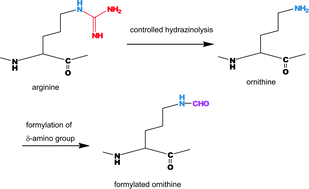Conversion of arginine to ornithine for improving the fragmentation pattern of peptides labeled with the N-terminal tris(2,4,6-trimethoxyphenyl)phosphoniumgroup in tandem mass spectrometry†
Abstract
We propose a method of converting

* Corresponding authors
a
Institute for Protein Research, Osaka University, Suita, Japan
E-mail:
kuyama@protein.osaka-u.ac.jp
Fax: +81-6-6879-4320
Tel: +81-6-6879-4320
b Life Science Research Center, Shimadzu Corporation, Kyoto, Japan
c Department of Chemistry, Nara Women's University, Nara, Japan
We propose a method of converting

 Please wait while we load your content...
Something went wrong. Try again?
Please wait while we load your content...
Something went wrong. Try again?
H. Kuyama, C. Nakajima, T. Nakazawa and O. Nishimura, Anal. Methods, 2010, 2, 1792 DOI: 10.1039/C0AY00439A
To request permission to reproduce material from this article, please go to the Copyright Clearance Center request page.
If you are an author contributing to an RSC publication, you do not need to request permission provided correct acknowledgement is given.
If you are the author of this article, you do not need to request permission to reproduce figures and diagrams provided correct acknowledgement is given. If you want to reproduce the whole article in a third-party publication (excluding your thesis/dissertation for which permission is not required) please go to the Copyright Clearance Center request page.
Read more about how to correctly acknowledge RSC content.
 Fetching data from CrossRef.
Fetching data from CrossRef.
This may take some time to load.
Loading related content
